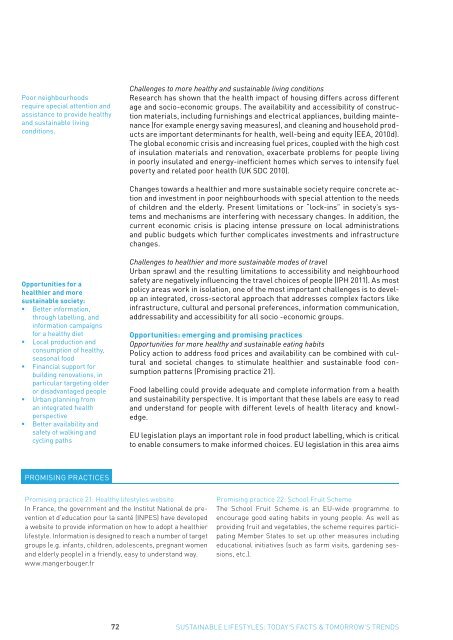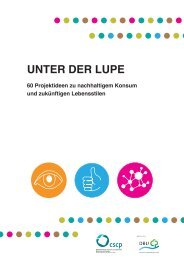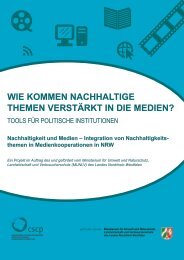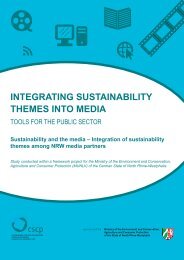today's facts & tomorrow's trends - SPREAD Sustainable Lifestyles ...
today's facts & tomorrow's trends - SPREAD Sustainable Lifestyles ...
today's facts & tomorrow's trends - SPREAD Sustainable Lifestyles ...
You also want an ePaper? Increase the reach of your titles
YUMPU automatically turns print PDFs into web optimized ePapers that Google loves.
Poor neighbourhoods<br />
require special attention and<br />
assistance to provide healthy<br />
and sustainable living<br />
conditions.<br />
Challenges to more healthy and sustainable living conditions<br />
Research has shown that the health impact of housing differs across different<br />
age and socio-economic groups. The availability and accessibility of construction<br />
materials, including furnishings and electrical appliances, building maintenance<br />
(for example energy saving measures), and cleaning and household products<br />
are important determinants for health, well-being and equity (EEA, 2010d).<br />
The global economic crisis and increasing fuel prices, coupled with the high cost<br />
of insulation materials and renovation, exacerbate problems for people living<br />
in poorly insulated and energy-inefficient homes which serves to intensify fuel<br />
poverty and related poor health (UK SDC 2010).<br />
Changes towards a healthier and more sustainable society require concrete action<br />
and investment in poor neighbourhoods with special attention to the needs<br />
of children and the elderly. Present limitations or “lock-ins” in society’s systems<br />
and mechanisms are interfering with necessary changes. In addition, the<br />
current economic crisis is placing intense pressure on local administrations<br />
and public budgets which further complicates investments and infrastructure<br />
changes.<br />
Opportunities for a<br />
healthier and more<br />
sustainable society:<br />
• Better information,<br />
through labelling, and<br />
information campaigns<br />
for a healthy diet<br />
• Local production and<br />
consumption of healthy,<br />
seasonal food<br />
• Financial support for<br />
building renovations, in<br />
particular targeting older<br />
or disadvantaged people<br />
• Urban planning from<br />
an integrated health<br />
perspective<br />
• Better availability and<br />
safety of walking and<br />
cycling paths<br />
Challenges to healthier and more sustainable modes of travel<br />
Urban sprawl and the resulting limitations to accessibility and neighbourhood<br />
safety are negatively influencing the travel choices of people (IPH 2011). As most<br />
policy areas work in isolation, one of the most important challenges is to develop<br />
an integrated, cross-sectoral approach that addresses complex factors like<br />
infrastructure, cultural and personal preferences, information communication,<br />
addressability and accessibility for all socio -economic groups.<br />
Opportunities: emerging and promising practices<br />
Opportunities for more healthy and sustainable eating habits<br />
Policy action to address food prices and availability can be combined with cultural<br />
and societal changes to stimulate healthier and sustainable food consumption<br />
patterns (Promising practice 21).<br />
Food labelling could provide adequate and complete information from a health<br />
and sustainability perspective. It is important that these labels are easy to read<br />
and understand for people with different levels of health literacy and knowledge.<br />
EU legislation plays an important role in food product labelling, which is critical<br />
to enable consumers to make informed choices. EU legislation in this area aims<br />
Promising practices<br />
Promising practice 21: Healthy lifestyles website<br />
In France, the government and the Institut National de prevention<br />
et d’education pour la santé (INPES) have developed<br />
a website to provide information on how to adopt a healthier<br />
lifestyle. Information is designed to reach a number of target<br />
groups (e.g. infants, children, adolescents, pregnant women<br />
and elderly people) in a friendly, easy to understand way.<br />
www.mangerbouger.fr<br />
Promising practice 22: School Fruit Scheme<br />
The School Fruit Scheme is an EU-wide programme to<br />
encourage good eating habits in young people. As well as<br />
providing fruit and vegetables, the scheme requires participating<br />
Member States to set up other measures including<br />
educational initiatives (such as farm visits, gardening sessions,<br />
etc.).<br />
72<br />
SUSTAINABLE LIFESTYLES: TODAY’S FACTS & TOMORROW’S TRENDS
















